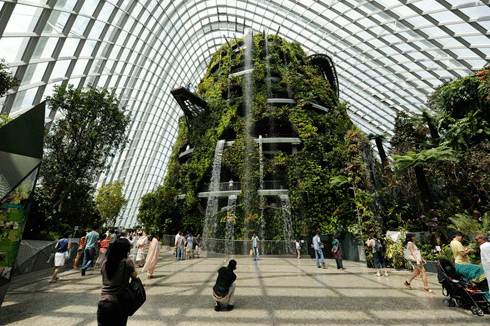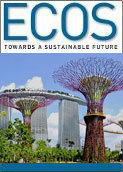
|
Published: 12 March 2013
Save or recreate? Lessons from Singapore on the value of green spaces
With development nibbling away at long-established green spaces in and around Australia’s largest cities, could we look to intensively urbanised Singapore for some wisdom on the value of such spaces for city dwellers?
Singapore – the world’s wealthiest nation by GDP per capita – has limited room to move when it comes to sustainable development.1 Its lack of land area (its total area is just 712 square kilometres), rivers, strong winds and geothermal energy, for example, restrict the city-state’s prospects for alternative energy sources.
Recently, however, the tiny intensively urbanised island – whose official population has almost doubled in the past 20 years to 5.2 million – began its journey to becoming a ‘City in a Garden’.
This new policy initiative is expected not only to cement its position as Asia’s most sustainable city, but to also pay dividends in terms of its liveability and boost its appeal to foreign business investment.
‘Our former Prime Minister Mr Lee Kuan Yew had the vision of making Singapore a Garden City in 1963,’ says Mr Poon Hong Yuen, CEO of Singapore’s National Parks Board.
‘It was a revolutionary concept in those days when “going green” was not fashionable. Yet Mr Lee and Singapore’s pioneers persisted in the vision because they believed it would mitigate against the harsh urban environment as Singapore developed, improve the quality of life for Singaporeans, and remind investors that Singapore was a place where things worked.’
The conventional thinking is that the development of a country, and especially of a small city state, would take place at the expense of greenery and nature, he adds. ‘But even as Singapore’s population and economy grew, the green cover of Singapore, as measured from satellite images, actually grew significantly.
‘Today, our 1.4 million roadside trees form the backbone of our Garden City while parks and gardens take their place as key community spaces.
‘One of the four nature reserves in Singapore, the Bukit Timah Nature Reserve, is also one of two primary rainforests in the world located within city limits, the other being Rio De Janeiro.’
Mr Poon says the City in a Garden vision will help strengthen Singapore’s brand as a distinctive, liveable city.
‘There are three key pillars of the City in a Garden vision. First is pervasive greenery. We have greenery everywhere, from the ground to the facade and rooftops of buildings. Second is infusing biodiversity into our urban landscapes. The third [pillar] is community involvement – active participation, ownership and pride among the community will sustain the City in a Garden vision.’
As well as developing the world-class Gardens by the Bay (see box below) and enhancing selected regional parks, the City is also developing more green corridors or ‘park connectors’, making use of drainage and road reserves to link housing estates to parks and nature sites.
‘We have about 220 km of park connectors now and aim to extend the network to 300 km by 2015,’ Mr Poon says. ’As an extension of this park connector network, we are also planning the round island route, a 150 km green recreational corridor that goes around Singapore.’
Most the city’s population live in high-rise apartments. Selling points in real estate ads aimed at attracting buyers to new residential developments include proximity to a park, or the inclusion of rooftop or vertical greenery.
‘The quantifiable benefit is land value appreciation, but there is also the unquantifiable benefit of living near rich biodiversity, which can result in improved physical and mental health,’ Mr Poon says.
How does he account for that fact that, in the past, the Singapore government has turned green spaces into air-conditioned shopping malls and high-rise developments? In Mr Poon’s view, the government has successfully balanced development with conservation of Singapore’s rich biodiversity.
‘Tiny Singapore is home to 364 species of birds, about 75 per cent of the number of species found in France; 305 species of butterflies, or five times as many species as can be found in the United Kingdom; and 255 species of hard corals, more than a third of the world total and 70 per cent of [the number found] in the Great Barrier Reef,’ he says.
As part of efforts to evaluate biodiversity initiatives, Singapore, in collaboration with the Secretariat of the Convention on Biological Diversity, developed an index for cities to measure the progress of their biodiversity conservation efforts over time.
‘This index was developed in recognition that cities can, and increasingly will, play a major role in biodiversity conservation,’ says Mr Poon. ‘Now known as the Singapore Index on Cities’ Biodiversity, this self-assessment tool is being used by over 50 cities all over the world.’
Back in Australia, planning reforms recently introduced to Melbourne, Australia’s second largest city, will allow the continual encroachment of development on long-established ‘green wedges’ at the edge of the city, putting the future food security and air quality of urban areas at risk – not to mention loss of habitat, biodiversity and carbon savings.
The state government reforms are opening up thousands of hectares of green wedge land for housing and other developments such as shops, sawmills, schools and petrol stations.

|
|
Melbourne’s peri-urban fringe: finding its way into green wedges. Credit:
elizabethdonoghue via flickr under CC BY-NC-ND 2.0 licence
|
RMIT University's Professor of Planning Michael Buxton argues that these reforms are short-sighted and will benefit developers at the expense of agriculture and the environment.
Green wedges were first proposed in the late ‘60s by then Minister for Local Government (and later Premier) Rupert Hamer to concentrate outer urban growth along narrow ‘fingers’, with the areas between the corridors set aside to act as wedges of undeveloped land.
In 2010, urban growth corridors were expanded by 43,000 hectares followed by a further expansion of 6000 hectares in 2012. ‘This wrecked the principle of the wedges acting to contain urban growth,’ comments Prof. Buxton.
The wedges were originally intended to protect natural values including biodiversity, landscapes and water resources; protect agricultural land; and ensure there were areas for recreation, open space in public ownership and tourism, as well as making sure important natural resources such as sand and stone remained accessible.
‘This was clearly articulated in the original planning,’ Prof. Buxton says. ‘It had another important objective: that cities shouldn’t grow in an unconstrained way and that there is value in protecting non-urban areas for their own sake.
‘The other issue is food security: cities that survive best this century will be those that protect their hinterland, and not destroy food, water, biodiversity and other natural resources.
‘These issues have become much more important in the past 20 years, in ways the original designers didn’t foresee, and reinforce the importance of planning, and looking ahead 50 or 100 years.’
1 http://www.thewealthreport.net/The-Wealth-Report-2012.pdf





